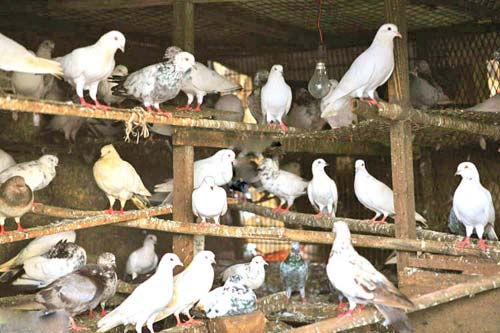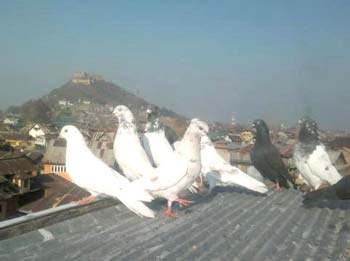Pigeon-keeping, cherished by Zamaindars and Nawabs of sub-continent is also dear to a certain section of Kashmiri society. Keeping pigeons as a hobby is believed to help in stress management. Bilal Handoo reports the trade and hobby revolving around pigeons.

The congested lanes in Nawa Kadal in Srinagar’s old city are bubbling with trade activities. Among the shops displaying a variety of commodities, those selling pigeons are instant crowd-puller.
In one of the pigeon shops, soiled with scattered seeds and pigeon waste, Ghulam Muhammad Khan, 65, is attending customers, who have keenly set their eyes on pigeons placed in wooden cages. “Pigeons keeping is a hobby,” says Khan, who is also a passionate pigeon keeper, “people from all walks of life are passionate about it.”
Mouser, Zeth, Kale-Krihun, Kale-Wozul, Zag-Doub, Zaag-Cheen and other varieties of pigeons are among the collection at Khan’s shop. “350 recorded varieties of pigeons are known to exist,” Khan informs.
One of the ‘eager’ customers on Khan’s shop is Manzoor Mir, 23, a bus conductor from Srinagar’s Noor Bagh area. This self-confessed pigeon buff spends major portion of his earnings every month to purchase new pigeons. Nobody from his family used to rear pigeons, until Mir developed passion for them during his early teens.
“I don’t know why, but I am naturally inclined towards pigeons,” says Mir, a gaunt faced young man with sunken eyes. “They (Pigeons) make me happy. Though my family resisted my passion earlier, but my devotion made them to approve of it later.”
Mir claims that ever since he got involved in pigeon keeping, he finds himself far from indulging in any social evil or bad company. “The beauty of this hobby is that, it prevents one from any type of bad company,” he explains, “as most of their free time goes into looking after their pigeons.”
But Mir is not alone who is brimming with an obsession for pigeon keeping. Shakeel Sofi, 36, a government employee is equally zealous in rearing white-flying-creatures. Living few meters away from Khan’s shop in Jamalatta locality, Sofi is keeping pigeons since his college days. “Many people in downtown would rear pigeons as a hobby, which also triggered a sense of fascination in me when I was growing up,” says Sofi, who is also on Khan’s shop to buy some new breed of pigeons.
Most parts in old city offers palpable glimpses of pigeon keeping. Square shaped wooden platforms meant for pigeons have been placed on the roof of several residential houses. But the craze for the pigeons is not new.
Many pigeon keepers in old city still remember Prof Want of Nawa Kadal, who was known during his lifetime as an ardent pigeon keeper. “Prof Want was famous for two things: one for his English teaching skills and other for his pigeon keeping passion,” Sofi says, “besides him, there used to be many higher government officials who were and are the part of this hobby.”
People associated with pigeon keeping claim that this hobby is hard to avoid, if once embarked upon. Zahoor Ahmad, 45, from Jamalatta is one such example. This average built man with a gruff in voice had left pigeon keeping some 30 years ago, but his lost hobby got invigorated lately. “There is some natural charm in pigeons, which makes it hard for a person to not fall for them,” Zahoor, who now sells pigeons on a shop near his residence, says. “Otherwise, how is it possible to pick up decades old leftover hobby once again?”
Given the large variety of pigeons available in local market, Zahoor says pigeon keepers purchase pigeons on the basis of eye color and time of flight undertaken by pigeons. “Pigeons who flight for more time are slated at higher price, as it is a sign for their endurance and vitality,” Zahoor says. “It has been found that in a single day, pigeons can fly between 600 and 700 miles.” He says Kashmir pigeons fail in exhibiting endurance and hence are not most-sought in local markets.

The rising mercury in the months of June/July also gives hint of fortitude in pigeons. “Pigeons who can withstand the heat of summers are valued more, as it determines their survival,” Zahoor says.
The time of flight also determines the price-tag of pigeons. A single pigeon can be valued between Rs 200 to 1 lakh on this factuality. “Recently one of the pigeon keepers sold a pair of pigeon for Rs 90 thousand,” Khan claims. “The pair was a rare Pakistani breed. Pakistani pigeons are more priced than other available breeds in local markets.”
Khan says that earlier people used to cross LoC and would bring Pakistani pigeons in local markets, but now, the markets across Kashmir are flooded with pigeons from Punjab and adjoining areas. “The major supply of pigeons in local market is mainly from Amritsar border area,” Khan informs.
The mass devotion to pigeon keeping also keeps sales chart ticking. In summers, on an average, 1000 to 2000 pigeons are being sold per month by a single shop keeper in Nawa Kadal, which in winters dip to 200 to 400. The average rate remains between Rs 500-1500 on a single pigeon. “If purchased at Rs 1000, the shopkeepers sell a single pigeon at Rs 1500,” Khan claims, “the industry is already running in crores of rupees.”
Many argue that pigeons navigate by sensing the earth’s magnetic field and using the sun for direction. Other theories suggest that they make use of roads and even low frequency seismic waves to find their way home.
Pigeon keepers train their white-flying-pets in such a manner that they develop a sense of acquaintance with their surroundings. During that period, certain feathers of their wings are clipped (locally called Kanch). “After 40 days, the wings again grow into full size,” Khan says. “Till that period, pigeon learns to recognize its dwelling.”
Apart from Nawa Kadal, pigeon sellers can be spotted in Srinagar’s Saida Kadal, HMT, Zaldagar and in other places.
But pigeon keeping is not mere urban obsession. Its spread to other parts of Kashmir as well. In south Kashmir’s Islamabad district, which is about 55 km from summer capital of J&K, the oldest surviving pigeon keeper is Mohammad Yousuf, 65, a tobacco grocer. He started his ties with pigeon keeping way back in 1964.
“When I started pigeon keeping, only few people in the whole district were known to be part of it,” Yousuf, who has build a separate house for his hundreds of pigeons, says. “That time, a single pigeon was sold at Rs 2.5 in Srinagar.”
He claims that presently Islamabad district is far ahead in pigeon keeping than Srinagar. “Though people in both districts share same passion, but presently Islamabad district has an edge over Srinagar in terms of numbers,” Yousuf says.
Of late, pigeon keepers from Srinagar as well as from Islamabad district have started to organize an annual pigeon competition on the pattern of Pakistani and Punjabi pigeon keepers. The event is separately held in both the districts in the months of June/July.
“Each participant has to ensure participation of his 5 pigeons in a competition,” Asif Guroo, a pigeon keeper from Islamabad district, says. “Prize money of Rs 1 lakh is given to winner, whose pigeons record highest time of flight. But in a cloudy day, the competition is usually postponed due to lack of clear sight. Two neutral judges monitor the event.”
The average life span of pigeons varies from 3-5 years. “Some even attain an age of 15 years, which depends on many factors, including right diet, least risk of predation and human interference,” says Guroo.
But lately, pigeon selling is turning out to be a business of losses. Both sellers and keepers are complaining that some ‘mysterious’ eye disorders, twisted neck and other ailments are affecting pigeons and thereby reducing their life span. Besides, known predators like cat and falcon (locally Baaz) love to prey pigeons. “We are compelled to use eye drops and medicines meant for humans, as no veterinary doctor is able to treat ailing pigeons,” says Guroo.
As the pigeons are falling to enigmatic ailments, many eyes are now turning towards pigeon diet. Seeds form the major component of the diet, but it varies greatly according to species. Some ground feeding species eat fruit and take insects and worms. “Presently, the available pigeon feed in markets is either rotten or pesticide-laden,” Yousuf says, “Besides most of the pigeons feed on human refuse, such as fast food waste.”
But in spite of these hiccups, Yousuf claims more and more people are presently rearing pigeons. “It is turning out to be a well sought-after hobby,” he says “For me, it is stress buster.”















